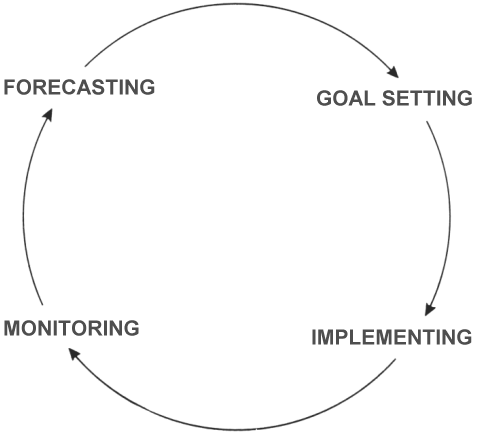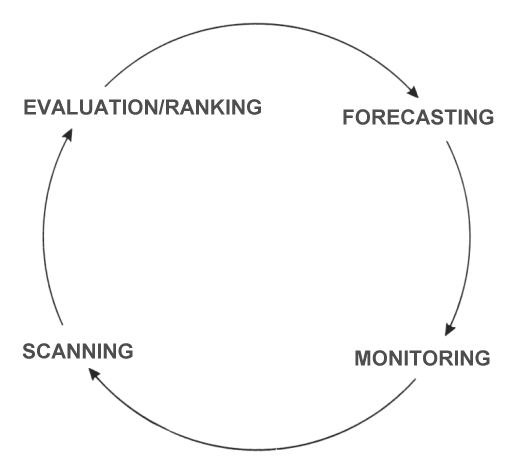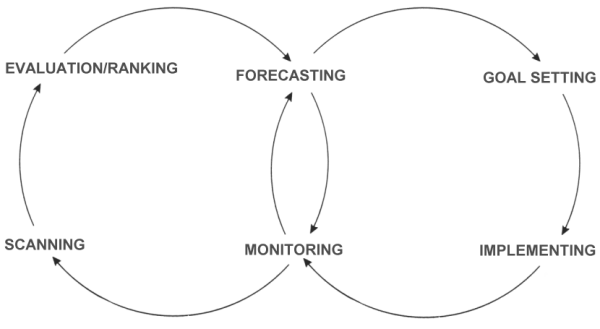| THE STRATEGIC PLANNING PROCESS | PREVIOUS | CONTENTS | NEXT |
| Early forecasting and futures research methods focused on indicators and measures of surface change. |
Finally, Braudel discovered a third level of history-one derived and focused on individual attitudes, values, and beliefs. He argued that these forces bring institutional and structural changes, which in turn bring the changes in the surface indicators. These three levels-superficial, structural/historical, and attitudinal-can be recursive; that is, surface changes "cause" structural changes, which cause changes in values, which then cause changes on the other levels. Consider, for example, how reliable, inexpensive birth control affected society's sexual values and how these value changes affected school enrollments.
These three levels of history can also serve as a means for viewing the future. Early forecasting and futures research methods focused on indicators and measures of surface change, such as unemployment, inflation, economic growth, sales of automobiles, and housing starts. Most of our discussions of the future still focus on these surface indicators, usually using implicit forecasts. For example, on the first page of the Wall Street Journal every day is a historical chart of some surface indicator from which readers can derive their own forecast. This serves to establish the unarticulated, implicit forecast.
Given this view of the future, it is not surprising futures research and forecasting developed and used a host of extrapolative methods in support of long-range planning focused on surface indicators. These methods included, among others, regression analysis, mathematical and judgmental trend extrapolation, Box-Jenkins, and rolling averages. The focus of this traditional long-range planning was internal, based on tracking and forecasting an organization's or a system's internal development.
As surprise developments continued to upset the forecasts and long-range plans produced by these methods, forecasters modified them to take explicit account of unprecedented, new developments and external "surprises." While many of them were surprises on the surface, futures researchers began to increasingly include changing structural and institutional developments. Thus, trend extrapolation was modified to become trend-impact analysis, a probabilistic forecasting technique in which an extrapolative trend is modified by the occurrence of hypothesized external surprise events.
At the same time, models of large systems created through the method known as systems dynamics were modified to include similar external surprises; with this modification, it became known as probabilistic systems dynamics. Relationships among external surprise events were also explored through such methods as cross-impact analysis. Most recently, in the mid-1970s, a method for guiding the development of responses to information about the future on the first two levels was developed--policy impact analysis. While a small scan of the external environment usually was made to identify candidate surprise events, the focus remained on the trends and issues developed from the traditional, internal perspective.
Today, methods are used that will take account of information from the third level of the future--changing values and attitudes. But these methods are in their infancy in this sort of application, and their users frequently have no clear idea of what balance should be struck among potential developments on all three levels. Coping seriously with this question is one of the frontiers of futures research. While we could of course approach this question through opinion research, opinion research has been notoriously weak in forecasting for the simple reason that individual opinion about the future is much more unreliable than opinion about the present. But the real difficulty with polling is not that individuals are unreliable; it is that pollsters who have tried forecasting have aimed at predictive accuracy with "one-shot" estimates. That is, they failed to provide respondents feedback on the original judgment, thereby prohibiting their using that information to reflect on the initial judgments or the arguments behind them. Consequently, the polling technique is limited in obtaining that information useful for managing change and increasing our options.
As futures research and forecasting methods became less quantitative and more qualitative, the process of exploring and responding to changing social structure and values (the second and third levels of the future) was becoming more and more important. The traditional "fire fighting" mode of public relations was modified to include a planning or forecasting role in what became known as public affairs. This role was extended to include policy planning. Thus, it is not unusual to find on a contemporary corporate organizational chart a director of public policy planning, a position stationed philosophically somewhere between the traditional public relations/government relations/public affairs function and the corporate planning function. In some organizations, the policy planning function has been extended to include a director of public issues, who is responsible for anticipating and helping the organization to respond to emerging issues in the external environment. The new field of issues management emerged as public relations and public affairs officers recognized the need to expand the use of forecasting and futures research in their planning and analysis of policy. The merger of futures research concepts and techniques into public policy planning holds the prospect that administrators will eventually pay much closer attention to detailed information about the future on all three levels discussed earlier.
Currently the most common technique used for including more information about the external world from both the second and third levels (structural/institutional change and attitudinal change) is environmental scanning. As with earlier forecasting, environmental scanning focuses first on the surface indicators--derived from newspapers, literature, and periodicals--as signals of underlying change in the more difficult-to-understand structural and attitudinal levels. Although refinements in environmental scanning will have to be developed, this approach to long-range planning moves us into the strategic planning process.
Strategic Planning Most colleges and universities currently engage in long-range planning,
but they can fruitfully augment that work by using the concepts of
strategic planning and thereby enhance their ability to steer a course in
a changing external environment. This section briefly describes the
traditional models for long-range planning and environmental scanning and
then shows how these two models can be merged to provide the basis of a
strategic planning process. Traditional long-range planning in its most elementary form is based on
the concept that planning consists of at least four key steps--monitoring,
forecasting, goal setting, and implementing--which are intended to answer
these questions: (1) Where is the organization now? (2) Where is it going?
(3) Where does it want to go? and (4) What does it have to do to change
where it is going to get to where it wants to go? (Renfro 1980b, 1980c;
see figure 1). Performing these activities is a continuing process that,
for example, produces a one-year operating plan and a five- or ten-year
long-range plan every year. The long-range planning cycle begins by
monitoring selected trends of interest to the organization,
forecasting the expected future of those trends (usually based upon
extrapolation from historical data using regression analysis or a similar
technique), defining the desired future by setting organizational
goals in the context of the expected future, developing and
implementing specific policies and actions designed to reduce the
difference between the expected future and the desired future, and
monitoring the effects of these actions and policies on the
selected trends. The environmental scanning model (figure 2) begins with scanning
the external environment for emerging issues that pose threats or
opportunities to the organization. As part of this step, trends are
specified that describe the issues and can be used to measure changes in
their nature or significance. Each potential issue or trend is then
analyzed (evaluation/ranking) as to the likelihood
that it will emerge and the nature and degree of its impact on the
organization if it should actually materialize. This stage produces a rank
ordering of the issues and trends according to their importance to current
or planned operations. The next stage, forecasting, focuses on
developing an understanding of the expected future for the most important
issues and trends. In this stage, any of the modern forecasting techniques
may be used. Once the forecasts are made, each issue and trend is then
monitored to track its continued relevance and to detect any major
departures from the forecasts made in the preceding stage. Monitoring,
in effect, identifies areas for additional and continued scanning.
For example, subsequent monitoring may begin to suggest that an
original forecast of the employee turnover rate is no longer credible,
which would imply the need for more focused scanning, forecasting, and
analysis to develop a more credible projection (see Renfro and Morrison
1984). As noted earlier, one of the major limitations of the traditional
long-range planning model is that information about the changing external
environment is usually not taken into account systematically or
comprehensively. When this omission occurs because of an assumption that
"we cannot predict external changes," long-range planning destines itself
to surprise and failure, if only because it locks itself to the
information known from direct experience in the past and immediate
present. Information from the external environment adds important components to
long-range planning, however. First, it identifies new and potentially
crucial subjects that should be added to those identified and tracked
during monitoring. Second, it identifies possible developments that must
be used to adjust the forecasts of the internal issues derived from
forecasting--specifically, the surprise events that are used in policy
impact analysis or techniques like probabilistic systems dynamics and in
other rigorous forecasting methods used in traditional long-range
planning. These two models of planning-long-range planning and environmental
scanning-may be merged. The interrelated model, the strategic planning
process, consists of six identifiable stages: environmental scanning,
evaluation of issues, forecasting, goal setting, implementation, and
monitoring (see figure 3). The merged model, then, allows information from
the external environment in the form of emerging developments to enter the
traditionally inwardly focused planning system, thereby enhancing the
overall effectiveness of an institution's planning. More specifically, it
allows the identification of issues and trends that must be used to modify
the internal issues derived during monitoring. The argument for combining these two models becomes apparent when the
future that happens to the institution and the future that happens
for the institution are contrasted. In the future that happens to
the institution (the typical "planned" future), new developments are not
anticipated before they force their way to the top of the agenda,
demanding crisis management and the latest fire-fighting techniques. In
this future, issues are usually defined by others whose interests do not
necessarily include those of the institution or its purpose. Not only are
threats from the external environment not anticipated as early as
possible; key opportunities will be missed or diminished in value. In the future that happens for the institution, in contrast (the
"strategic" future), administrative leadership is focused more on fire
prevention and less on fire fighting. Hence, it is able to exercise more
careful judgment in the orderly and efficient allocation of resources.
Certainly management will still have to deal with unforeseen developments,
but they will probably be fewer and less traumatic. Thus, institutions
will be able to pursue their mission with greater confidence and
consistency because they will be interrupted by fewer and smaller
fire-fighting exercises.
The word "strategy" comes from the Greek strategos, referring to a
military general and combining stratos (the army) and ago
(to lead). The primary tasks of strategic management are to understand
the environment, define organizational goals, identify options, make and
implement decisions, and evaluate actual performance. Thus, strategic
planning aims to exploit the new and different opportunities of tomorrow,
in contrast to long-range planning, which tries to optimize for tomorrow
the trends of today (Drucker 1980, p. 61).
FIGURE 1
LONG-RANGE PLANNING
FIGURE 2
ENVIRONMENTAL SCANNING
FIGURE 3
THE STRATEGIC PLANNING PROCESS
Source: Renfro and Morrison 1984.
| PREVIOUS | CONTENTS | NEXT |